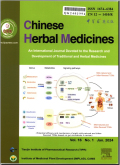摘要Objective:Goji(fruits of Lycium spp.)is commonly consumed as food and medicine.The increasing mar-ket demand for goji has led to its wide cultivation and broad breeding,which might cause loss of genetic diversity.This study aims to uncover the genetic diversity of the cultivated and wild Lycium.Methods:The chloroplast genome(CPG)of 34 accessions of Chinese food-medicinal Lycium spp.,includ-ing the popular cultivars and their wild relatives,was re-sequenced and assembled,based on which the genetic diversity was evaluated.Results:Sequence structural comparison shows that CPG is comparatively conserved within species.Phylogenetic analysis indicates that CPG is sufficient for the discrimination of Lycium species;combined with nuclear ribosomal internal transcribed spacer(Nr ITS)sequences,materials with mixed genetic backgrounds can be identified.Nucleotide diversity analysis reveals that the modern cultivars are prob-ably with a common maternal parent,while the wild accessions are with higher level of genetic diversity.Conclusion:For the first time this study reveals the intraspecies genetic diversity of Lycium spp.using CPG,highlighting the urgent conservation demand of wild genetic resources of Lycium.Our study also demonstrates that CPG provides crucial evidence for identification of Lycium species with mixed genetic backgrounds and highlights the importance of the wild relatives in genetic diversity conservation.This CPG-based technology will contribute to the sustainable development of medicinal plants broadly.
更多相关知识
- 浏览8
- 被引1
- 下载0


相似文献
- 中文期刊
- 外文期刊
- 学位论文
- 会议论文



 换一批
换一批 换一批
换一批



